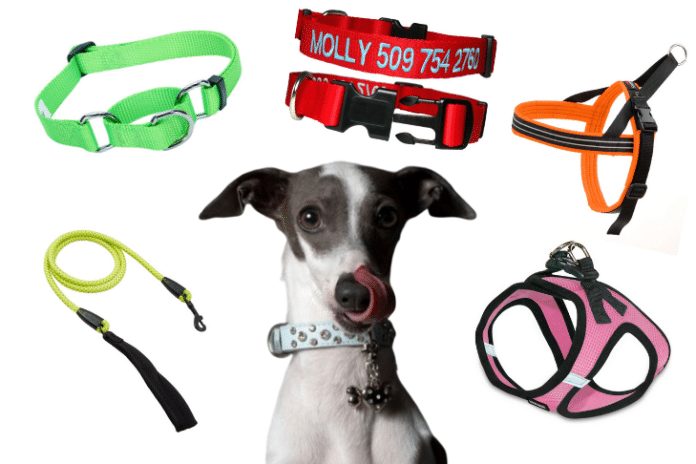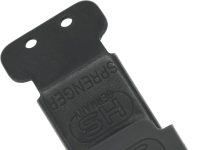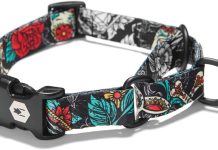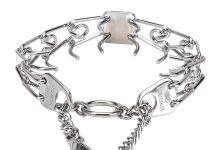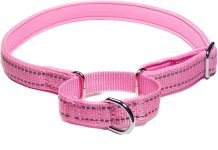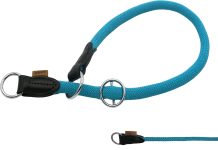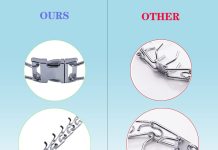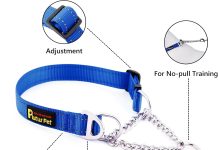Let’s explore the world of dog-training collars! From shock collars to spray collars, there is an array of options to choose from when training your furry friend. This article will examine the various types of dog training collars available, discussing their benefits and potential drawbacks.
Whether you are a seasoned dog owner or a first-time pup parent, understanding the options will help you decide on your canine companion’s training needs. So, let’s dive in and discover the possibilities!
Yes, there are various types of dog training collars available in the market. These collars serve different purposes and are designed to suit different training methods and needs.
In this article, we will explore the different types of dog training collars and discuss their descriptions, suitability, training methods, advantages, and disadvantages.
By understanding the features and uses of each type of collar, you can decide which collar is most appropriate for your dog.
Table of Contents
Flat Collars
Flat collars are the most common type of dog collar that you will come across. They are simple in design, consisting of a flat strip of material with a buckle or clasp for fastening around the dog’s neck. These collars can be made of nylon, leather, or fabric and are available in a wide range of colors and patterns.
Flat collars suit most dogs, especially well-behaved dogs, and do not require extensive training. They are ideal for everyday use, such as attaching identification tags and leash walking.
Regarding training, flat collars can be used for basic commands and leash manners. However, they are not effective for dogs who have a tendency to pull or exhibit leash-reactive behaviors.
One of the advantages of flat collars is their simplicity and affordability. They are easy to put on and take off and come in various sizes to fit different breeds. However, flat collars do not provide much control or correction, so they may not be suitable for dogs with behavior issues.
Martingale Collars
Martingale collars, also known as limited-slip collars, are designed to provide more control and prevent dogs from slipping out of their collars. They consist of a flat collar with an additional loop of material that tightens when tension is applied to the leash. This tightening action mimics the correction of a choke collar but without causing harm or discomfort to the dog.
Martingale collars are suitable for dogs who tend to back out of their collars or have necks that are larger than their heads, such as Greyhounds and Whippets. They are also a good choice for dogs who are prone to pulling on the leash or have a tendency to escape.
In terms of training, martingale collars can be used to discourage pulling and reinforce leash manners. When the dog pulls, the collar tightens slightly, reminding the dog to stay by their handler’s side.
One advantage of martingale collars is that they provide a balance between control and comfort. They prevent dogs from slipping out of their collars while minimizing the risk of injury. However, it’s essential to ensure the martingale collar is fitted correctly to avoid excessive tightening and discomfort for the dog.
Prong Collars
Prong pinch collars, or training collars, are controversial and often misunderstood. They consist of interlocking metal links with prongs facing inward towards the dog’s neck. When tension is applied to the leash, the prongs create pressure points on the dog’s neck, simulating the bite of a pack leader.
Prong collars are suitable for strong-willed, powerful dogs who require a higher level of control during training. They are commonly used by professional trainers and handlers working with large breeds, such as German Shepherds or Rottweilers. However, it is essential to note that prong collars should only be used under the guidance of an experienced trainer.
Regarding training, prong collars are designed to provide immediate and effective corrections. The pressure created by the prongs can deter pulling, jumping, and other unwanted behaviors. However, learning how to use a prong collar correctly is crucial to avoid causing harm, such as creating punctures or injuries to the dog’s neck.
One advantage of prong collars is their ability to provide quick feedback and control. They can be effective for dogs who are not responding to other training methods. However, it is essential to consider the potential risks and consult with a professional trainer before using a prong collar.
Head Halters
Head halters, also known as head collars or gentle leaders, are designed to give the handler control over the dog’s head, thus steering their body. They consist of a strap that fastens around the dog’s muzzle and another strap that goes behind their ears, with the leash attaching under the chin.
Head halters are suitable for dogs who are strong, prone to pulling, or have difficulty walking on a leash. They are particularly useful for dogs who have a tendency to lunge or display reactive behaviors. Head halters can provide immediate control by redirecting the dog’s attention to the handler when they exhibit unwanted behaviors.
In terms of training, head halters help reduce pulling and allow the handler to guide the dog’s direction and focus. They work on the principle of utilizing the dog’s natural instinct to follow their head and redirecting their attention towards the handler. It’s essential to gradually introduce and acclimate dogs to head halters to ensure they are comfortable and not stressed or anxious.
One advantage of head halters is their ability to provide control without causing discomfort or pain to the dog. They allow for gentle steering and can effectively teach dogs to walk nicely on a leash. However, some dogs may take time to adjust to wearing a head halter, and improper fitting or use can cause discomfort or injury to the dog’s neck or muzzle.
Choke Chains
Choke chains, also known as slip collars, are designed to provide control by tightening around the dog’s neck when tension is applied to the leash. They consist of a metal chain with a ring at each end, forming a loop that can slide through one of the rings to create a choking effect.
Choke chains are suitable for dogs who require additional control during training, such as those who pull excessively or exhibit aggressive behaviors. They are commonly used in obedience training or sports activities, but they should only be used under the guidance of an experienced trainer.
In terms of training, choke chains are intended to provide corrective feedback by giving a quick, discomforting sensation when the dog pulls or misbehaves. The tightening action mimics the correction of a pack leader, discouraging the unwanted behavior. Using choke chains correctly and avoiding prolonged or excessive pressure on the dog’s throat is essential to prevent injury or strangulation.
One advantage of choke chains is their ability to provide quick and effective corrections when appropriately used. They can be effective for dogs who require firm guidance during training. However, it is crucial to understand how to use a choke chain correctly to avoid causing harm or distress to the dog.
Electronic Collars
Electronic collars, also known as shock collars or remote training collars, are designed to deliver electrical impulses or vibrations to the dog’s neck when activated by a handheld remote control. They consist of a collar with a receiver and a remote control with various stimulation levels.
Electronic collars are suitable for dogs who require off-leash training, hunting, or specialized training. They are commonly used by professional trainers and handlers who need a reliable and immediate method of communication with their dogs over long distances. However, they should only be used with caution and under the guidance of an experienced trainer.
In terms of training, electronic collars can be used to reinforce commands, discourage unwanted behaviors, and establish boundaries. The levels of stimulation can be customized based on the dog’s sensitivity and the nature of the training. It is crucial to use electronic collars responsibly, ensuring that the stimulation is appropriate and not causing harm or distress to the dog.
One advantage of electronic collars is their ability to provide precise and remote control over the dog’s behavior. They can be effective for dogs who require reliable off-leash training or have a high prey drive. However, electronic collars should only be used as a last resort and after exploring other training methods.
Citronella Collars
Citronella collars are designed to deter unwanted behaviors by releasing a burst of citronella spray when activated. They consist of a collar with a canister of citronella and a microphone or vibration sensor that detects the dog’s barking or other behaviors.
Citronella collars are suitable for dogs who have excessive barking or engage in other unwanted behaviors, such as jumping or digging. The release of citronella acts as a distraction and can interrupt the dog’s behavior pattern without causing harm or discomfort.
Regarding training, citronella collars provide a form of aversive conditioning by associating unwanted behavior with an unpleasant smell. Over time, the dog may learn to associate the unwanted behavior with the scent of citronella and reduce or cease the behavior. Using citronella collars consistently and with positive reinforcement training methods is essential.
One advantage of citronella collars is their ability to deter unwanted behaviors without causing harm or pain to the dog. They are a humane and safe alternative to other aversive training methods. However, citronella collars may not be effective for all dogs, and some dogs may become desensitized to the scent over time.
Ultrasonic Collars
Ultrasonic collars are designed to interrupt and deter unwanted behaviors by emitting a high-pitched ultrasonic sound when activated. They consist of a collar with a built-in microphone and speaker.
Ultrasonic collars are suitable for dogs with excessive barking or other unwanted behaviors. The high-pitched sound can be unpleasant to the dog’s ears and act as a deterrent.
In terms of training, ultrasonic collars provide an aversive stimulus that interrupts the dog’s behavior. The sound is activated by certain behaviors, such as barking or jumping, and can help the dog associate the unwanted behavior with an unpleasant sound. Using ultrasonic collars consistently and in conjunction with positive reinforcement training methods is essential.
One advantage of ultrasonic collars is their ability to deter unwanted behaviors without causing harm or discomfort to the dog. They are a humane and non-invasive option for training. However, some dogs may become habituated to the sound or may not be affected by it, rendering the collar ineffective.
Vibration Collars
Vibration collars, also known as vibratory collars, are designed to interrupt and redirect the dog’s attention by delivering a vibration sensation when activated. They consist of a collar with a small electronic device emitting vibrations.
Vibration collars are suitable for dogs who require a gentle reminder or redirection during training. They can get the dog’s attention or interrupt unwanted behaviors without causing harm or discomfort.
In terms of training, vibration collars provide a redirection or interruption to the dog’s behavior. The vibration is a distraction and can reinforce commands or redirect the dog’s attention. Using vibration collars with positive reinforcement training methods is essential to ensure that the dog associates the vibration with a positive or neutral experience.
One advantage of vibration collars is their ability to provide a gentle and non-aversive form of correction or redirection. They are a humane and safe option for training. However, vibration collars may not be effective for all dogs, especially those that are highly aroused or have a high pain threshold.
Smart Collars
Intelligent collars, also known as GPS collars or activity trackers, are designed to provide additional features beyond essential collar functions. They consist of a collar with built-in technology, such as GPS tracking, activity monitoring, or health tracking.
Intelligent collars are suitable for dog owners who want to keep track of their dog’s location, monitor their activity levels, or receive health-related information. These collars can be particularly useful for outdoor enthusiasts, pet parents with adventurous dogs, or those with dogs who have certain health conditions.
In terms of training, smart collars do not directly contribute to training methods or behaviors. However, they can provide valuable information to help monitor the dog’s progress, identify patterns, or track fitness goals.
One advantage of intelligent collars is their ability to provide a wealth of information and convenience for dog owners. They can assist in locating lost dogs, monitoring activity levels for health purposes, or tracking progress during training. However, it’s essential to consider smart collars’ specific features and compatibility with your dog’s needs and lifestyle.
In conclusion, there are multiple types of dog training collars available, each with its own characteristics, purposes, and considerations. It’s essential to understand each type’s descriptions, suitability, training methods, advantages, and disadvantages before choosing the suitable collar for your dog.
Remember always to prioritize the well-being and comfort of your dog, seek professional guidance if needed, and use positive reinforcement training methods alongside any chosen training collar.
By selecting the appropriate collar and employing proper training techniques, you can help your dog learn and thrive while maintaining a solid and loving bond with you.

